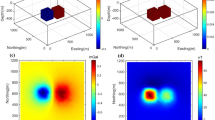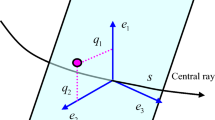Abstract
Potential field migration represents a rapid technique for imaging the subsurface based on gravity data. However, migration transformation usually produces a smooth and unfocused image of the targets due to the diffusive nature of the potential fields. In this paper, we introduce a method of the migration image enhancement and sharpening based on the application of the hybrid focusing stabilizer, which combines the edge-preserving smoothing filter with the minimum support functional. The method is based on the model resolution matrix of the migration operator. We also improve the migration image with a novel target-oriented migration method. The developed method of migration image enhancement and sharpening is illustrated by synthetic model studies and case studies. The case study involves imaging the full tensor gravity gradient data collected in the Nordkapp Basin of the Barents Sea.
























Similar content being viewed by others
References
AlBinHassan, N. M., Luo, Y., & Al-Faraj, M. N. (2006). 3D edge-preserving smoothing and applications. Geophysics,71(4), P5–P11. https://doi.org/10.1190/1.2213050.
Beiki, M. (2010). Analytic signals of gravity gradient tensor and their application to estimate source location. Geophysics,75(6), I59–I74. https://doi.org/10.1190/1.3493639.
Beiki, M., & Pedersen, L. B. (2010). Eigenvector analysis of gravity gradient tensor to locate geologic bodies. Geophysics,75(6), I37–I49. https://doi.org/10.1190/1.3484098.
Berkhout, A. J. (1980). Seismic migration: Imaging of acoustic energy by wave field extrapolation. New York: Elsevier.
Boulanger, O., & Chouteau, M. (2001). Constraints in 3D gravity inversion. Geophysical Prospecting,49, 265–280.
Bugge, T., Elvebakk, G., Fanavoll, S., Mangerud, G., Smelror, M., Weiss, H. M., et al. (2002). Shallow stratigraphic drilling applied in hydrocarbon exploration of the Nordkapp Basin, Barents Sea. Marine and Petroleum Geology,19(1), 13–37. https://doi.org/10.1016/S0264-8172(01)00051-4.
Claerbout, J. F. (1985). Imaging the earth’s interior. Oxford: Blackwell.
Fedi, M. (2007). DEXP: A fast method to determine the depth and the structural index of potential fields sources (Vol. 72).
Gernigon, L., Brönner, M., Fichler, C., Løvås, L., Marello, L., & Olesen, O. (2011). Magnetic expression of salt diapir-related structures in the Nordkapp Basin, western Barents Sea. Geology,39(2), 135–138. https://doi.org/10.1130/G31431.1.
Hornby, P., Boschetti, F., & Horowitz, F. G. (1999). Analysis of potential field data in the wavelet domain. Geophysical Journal International,137(1), 175–196. https://doi.org/10.1046/j.1365-246x.1999.00788.x.
Hu, J., Schuster, G. T., & Valasek, P. A. (2001). Poststack migration deconvolution. Geophysics,66(3), 939–952. https://doi.org/10.1190/1.1444984.
Koyi, H., Talbot, C. J., & Torudbakken, B. O. (1995). Analogue models of salt diapirs and seismic interpretation in the Nordkapp Basin, Norway. Petroleum Geoscience,1(2), 185–192. https://doi.org/10.1144/petgeo.1.2.185.
Koyi, H., Talbot, C. J., & Tørudbakken, B. O. (1993). Salt diapirs of the southwest Nordkapp Basin: Analogue modelling. Tectonophysics,228(3), 167–187. https://doi.org/10.1016/0040-1951(93)90339-L.
Li, Y. (2001). 3-D inversion of gravity gradiometer data. In Paper presented at the SEG Technical Program Expanded Abstracts 2001.
Li, Y., & Oldenburg, D. W. (1996). 3-D inversion of magnetic data. Geophysics,61(2), 394–408.
Li, Y., & Oldenburg, D. W. (1998). 3-D inversion of gravity data. Geophysics,63(1), 109–119.
Luo, Y., Marhoon, M., Dossary, S. A., & Alfaraj, M. (2002). Edge-preserving smoothing and applications. The Leading Edge,21(2), 136–158. https://doi.org/10.1190/1.1452603.
Malin, K. H. (2017). Improved constraint on salt geometry in the southern Nordkapp Basin. Master’s thesis, Norwegian University of Science and Technology, Norwegian University of Science and Technology.
Martinez, C., Li, Y., Krahenbuhl, R., & Braga, M. A. (2012). 3D inversion of airborne gravity gradiometry data in mineral exploration: A case study in the Quadrilátero Ferrífero, Brazil. Geophysics,78(1), B1–B11.
Paoletti, V., Fedi, M., Italiano, F., Florio, G., & Ialongo, S. (2016). Inversion of gravity gradient tensor data: Does it provide better resolution? Geophysical Journal International,205(1), 192–202. https://doi.org/10.1093/gji/ggw003.
Pilkington, M. (2012). Analysis of gravity gradiometer inverse problems using optimal design measures. Geophysics,77(2), G25–G31. https://doi.org/10.1190/geo2011-0317.1.
Pilkington, M. (2014). Evaluating the utility of gravity gradient tensor components. Geophysics,79(1), G1–G14. https://doi.org/10.1190/geo2013-0130.1.
Portniaguine, O., & Zhdanov, M. S. (1999). Focusing geophysical inversion images. Geophysics,64(3), 874–887. https://doi.org/10.1190/1.1444596.
Portniaguine, O., & Zhdanov, M. S. (2002). 3-D magnetic inversion with data compression and image focusing. Geophysics,67(5), 1532–1541. https://doi.org/10.1190/1.1512749.
Schneider, W. A. (1978). Integral formulation for migration in two and three dimensions. Geophysics,43(1), 49–76. https://doi.org/10.1190/1.1440828.
Schuster, G. (2017). Seismic inversion (investigations in geophysics). Tulsa: Society of Exploration Geophysicists.
Sun, J., & Li, Y. (2016). Joint inversion of multiple geophysical data using guided fuzzy c-means clustering. Geophysics,81(3), ID37–ID57.
Thompson, D. T. (1982). EULDPH: A new technique for making computer assisted depth estimates from magnetic data. Geophysics,47, 31–37.
Vasco, D. W. (1989). Resolution and variance operators of gravity and gravity gradiometry. Geophysics,54(7), 889–899. https://doi.org/10.1190/1.1442717.
Wan, L., Han, M., & Zhdanov, M. S. (2016). Joint iterative migration of surface and borehole gravity gradiometry data. In Paper presented at the SEG technical program expanded abstracts 2016.
Wan, L., & Zhdanov, M. S. Iterative migration of gravity and gravity gradiometry data. In 2013 SEG Annual Meeting, 2013: Society of Exploration Geophysicists.
Yu, J., Hu, J., Schuster, G. T., & Estill, R. (2006). Prestack migration deconvolution. Geophysics,71(2), S53–S62. https://doi.org/10.1190/1.2187783.
Yu, J., & Schuster, G. T. (2003). Migration deconvolution vs. least squares migration. In Paper presented at the SEG Technical Program Expanded Abstracts 2003.
Zhdanov, M. S. (2002). Geophysical inverse theory and regularization problem (Vol. 36). Oxford: Elsevier.
Zhdanov, M. S. (2009). Geophysical electromagnetic theory and methods (1st ed.). Oxford: Elsevier.
Zhdanov, M. S. (2015). Inverse theory and applications in geophysics (2nd ed.). Oxford: Elsevier.
Zhdanov, M. S., Cai, H., & Wilson, G. A. (2012a). Migration transformation of two-dimensional magnetic vector and tensor fields. Geophysical Journal International,189(3), 1361–1368.
Zhdanov, M. S., Ellis, R., & Mukherjee, S. (2004). Three-dimensional regularized focusing inversion of gravity gradient tensor component data. Geophysics,69(4), 925–937. https://doi.org/10.1190/1.1778236.
Zhdanov, M. S., & Lin, W. (2017). Adaptive multinary inversion of gravity and gravity gradiometry data. Geophysics,82(6), G101–G114. https://doi.org/10.1190/geo2016-0451.1.
Zhdanov, M. S., Liu, X., & Wilson, G. (2010a). Potential field migration for rapid 3D imaging of entire gravity gradiometry surveys. First Break,28(11), 47–51.
Zhdanov, M. S., Liu, X., & Wilson, G. A. (2010b). Rapid imaging of gravity gradiometry data using 2D potential field migration. In SEG Technical Program Expanded Abstracts 2010 (pp. 1132–1136). Society of Exploration Geophysicists.
Zhdanov, M. S., Liu, X., Wilson, G. A., & Wan, L. (2011). Potential field migration for rapid imaging of gravity gradiometry data. Geophysical Prospecting,59(6), 1052–1071.
Zhdanov, M. S., Liu, X., Wilson, G. A., & Wan, L. (2012b). 3D migration for rapid imaging of total-magnetic-intensity data. Geophysics,77(2), J1–J5.
Zhdanov, M. S., & Traynin, P. Inversion versus migration in two-dimensional geoelectrical problems. In 1996 SEG annual meeting, 1996. Society of Exploration Geophysicists.
Zhdanov, M. S., & Portniaguine, O. (1997). Time-domain electromagnetic migration in the solution of inverse problems. Geophysical Journal International,131(2), 293–309.
Zhdanov, M. S., Traynin, P., & Booker, J. R. (1996). Underground imaging by frequency-domain electromagnetic migration. Geophysics,61(3), 666–682. https://doi.org/10.1190/1.1443995.
Zhdanov, M. S., Traynin, P. N., & Portniaguine, O. (1995). Resistivity imaging by time domain electromagnetic migration (TDEMM). Exploration Geophysics,26(2/3), 186–194.
Acknowledgements
The authors acknowledge the support of the University of Utah’s Consortium for Electromagnetic Modeling and Inversion (CEMI) and of TechnoImaging. This work was also supported by the RSF, project no. 16-11-10188. We are thankful to Dr. B. Farrelly for providing the FTG data.
Author information
Authors and Affiliations
Corresponding author
Additional information
Publisher's Note
Springer Nature remains neutral with regard to jurisdictional claims in published maps and institutional affiliations.
Rights and permissions
About this article
Cite this article
Tu, X., Zhdanov, M.S. Enhancement and Sharpening the Migration Images of the Gravity Field and Its Gradients. Pure Appl. Geophys. 177, 2853–2870 (2020). https://doi.org/10.1007/s00024-019-02397-9
Received:
Revised:
Accepted:
Published:
Issue Date:
DOI: https://doi.org/10.1007/s00024-019-02397-9




